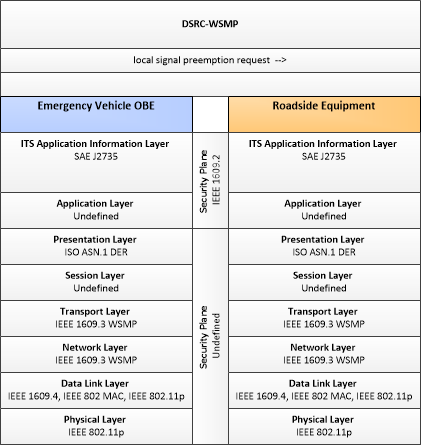Link Type: Short Range Wireless
Emergency Vehicle OBE --> Roadside Equipment:
local signal preemption request
Definitions
local signal preemption request (Information Flow): Direct control signal or message to a signalized intersection that results in preemption of the current control plan and grants right-of-way to the requesting vehicle.
Emergency Vehicle OBE (Source Physical Object): The Emergency Vehicle On-Board Equipment (OBE) resides in an emergency vehicle and provides the processing, storage, and communications functions that support public safety-related connected vehicle applications. It represents a range of vehicles including those operated by police, fire, and emergency medical services. In addition, it represents other incident response vehicles including towing and recovery vehicles and freeway service patrols. It includes two-way communications to support coordinated response to emergencies. In CVRIA, a separate 'Vehicle OBE' physical object supports the general V2V and V2I safety applications and other applications that apply to all vehicles, including emergency vehicles. The Emergency Vehicle OBE supplements these general capabilities with capabilities that are specific to emergency vehicles.
Roadside Equipment (Destination Physical Object): 'Roadside Equipment' (RSE) represents the Connected Vehicle roadside devices that are used to send messages to, and receive messages from, nearby vehicles using Dedicated Short Range Communications (DSRC) or other alternative wireless communications technologies. Communications with adjacent field equipment and back office centers that monitor and control the RSE are also supported. This device operates from a fixed position and may be permanently deployed or a portable device that is located temporarily in the vicinity of a traffic incident, road construction, or a special event. It includes a processor, data storage, and communications capabilities that support secure communications with passing vehicles, other field equipment, and centers.
Included In
This Information Flow is in the following Applications:
This Information Flow is in the following Application Objects:
Communication Diagrams
The communication diagram(s) can be viewed in SVG or PNG format and the current format is SVG. Switch to PNG format.
Characteristics
Architectural:
| Characteristic | Value |
|---|---|
| Time Context | Recent |
| Spatial Context | Adjacent |
| Acknowledgement | False |
| Cardinality | Broadcast |
| Initiator | Source |
Security
This information flow triple is in the following applications with the following security levels.
| Information Flow Security | |||||
|---|---|---|---|---|---|
| Application | Confidentiality | Integrity | Availability | ||
| Basis | Basis | Basis | |||
| Emergency Vehicle Preemption | Not Applicable | High | Moderate | ||
| It does not matter if someone is able to eavesdrop on this request. There will be many other more obvious indicators that the request was made, such as sirens and flashing lights on the emergency vehicle. | The system must be able to trust these requests. Emergency Vehicles should be able to send these requests and know that they are being operated on by the receiving system. Additionally, if an unauthorized vehicle is able to send these requests it could bring traffic to a standstill by disrupting signal coordination citywide. | The alternative to this request is existing mechanisms – such as using the sirens to stop traffic. The difference between the emergency signal preemption application and existing practice is not significant enough to justify a HIGH availability requirement. | |||
